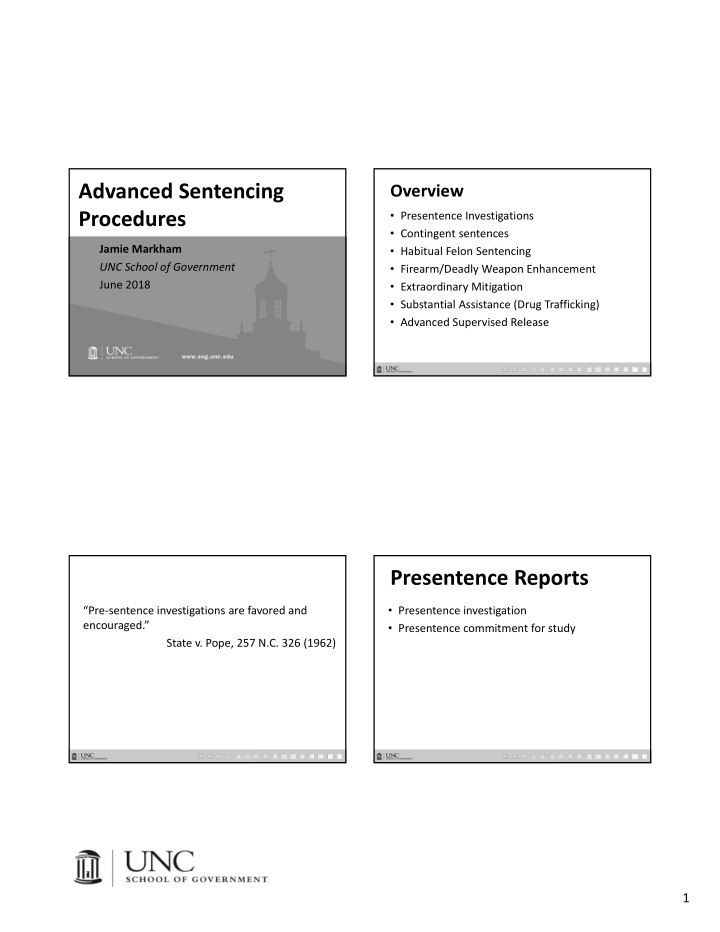



Advanced Sentencing Overview Procedures • Presentence Investigations • Contingent sentences Jamie Markham • Habitual Felon Sentencing UNC School of Government • Firearm/Deadly Weapon Enhancement June 2018 • Extraordinary Mitigation • Substantial Assistance (Drug Trafficking) • Advanced Supervised Release Presentence Reports “Pre ‐ sentence investigations are favored and • Presentence investigation encouraged.” • Presentence commitment for study State v. Pope, 257 N.C. 326 (1962) 1
Presentence Investigation Presentence Investigation • G.S. 15A ‐ 1332 • Prompt investigation into defendant’s: – Court may order PSI for any defendant – Health • Pre ‐ conviction on defendant’s motion – Family and social history – Completed by probation officer – Criminal history – History of substance abuse – Employment – Education • Tailored to your request Risk ‐ Needs Assessment Presentence Commitment • Risk assessment: • Any felony or Class A1 or 1 misdemeanor – Offender Traits Inventory, Revised (OTI ‐ R) • Requires defendant’s consent (except for sexually violent predator determination) • Needs assessment • Commit for up to 90 days – Officer interview + Offender self ‐ report • Coordinated through DAC Diagnostic Services – Will flag substance abuse, family issues 2
Presentence Reports “Contingent” Sentences • Active sentence followed by probation • Sentencing hearing may be held in different • Permitted under G.S. 15A ‐ 1346 district upon completion of report • Reports not a public record • Reports may be expunged upon request, in your discretion Habitual Felon • Four ‐ class enhancement, capped at C • HF sentences must run consecutively to other sentences “being served” • Prior convictions used to habitualize do not count toward prior record level – State may allege more than three – State may choose which convictions to allege – Consolidated/same week convictions: One for HF and one for prior record level – Masked conviction may still establish “bonus point” 3
Firearm/Deadly Weapon Firearm/Deadly Weapon • Minimum sentence enhancement if defendant • Offenses committed before 10/1/2013: “actually possessed and used, displayed, or – Class B1 ‐ E: 60 ‐ month enhancement threatened the use or display of a firearm or • Offenses committed on/after 10/1/2013: deadly weapon in committing a felony.” – Class B1 ‐ E: 72 ‐ month enhancement – Gun ‐ shaped cigare � e lighter ≠ Actual possession – Class F ‐ G: 36 ‐ month enhancement – Class H ‐ I: 12 ‐ month enhancement Firearm/Deadly Weapon Firearm/Deadly Weapon • Facts must be charged in indictment/information • Second ‐ degree kidnapping (Class E) – One pleading sufficient for all felonies tried together – Offense date: Jan. 4, 2016 • Proved to jury beyond a reasonable doubt, +72 – Prior record level II unless defendant pleads guilty – Firearm enhancement • Can’t be proved with evidence necessary to properly alleged, proved prove an element of the underlying felony • What is highest enhanced • Active sentences only MIN ‐ MAX from the presumptive range? 4
Extraordinary mitigation • Allows Intermediate probation in an “A” ‐ only cell of the sentencing grid when court finds: – Extraordinary mitigating factors of a kind significantly greater than in the normal case; – Those factors substantially outweigh any factors in aggravation; and – It would be a manifest injustice to impose an active punishment in the case Extraordinary mitigation • Exclusions – Cannot use with Class A or Class B1 felony – Cannot use for drug trafficking/conspiracy – Must have fewer than 5 prior record points 5
Extraordinary mitigation Extraordinary mitigation • Court must find extraordinary mitigating • Improper extraordinary mitigating factors factors “significantly greater than in the – “ The defendant’s level of mental functioning was insufficient to constitute a defense but significantly normal case” reduced his culpability.” – Quality, not quantity, makes mitigation – The 14 ‐ year ‐ old victim consented to the crime extraordinary – Cannot be an ordinary mitigating factor Extraordinary mitigation 6
Substantial Assistance Attempted Trafficking • Drug trafficking only • Reverts to regular sentencing grid for that class of offense • “Substantial assistance in the – Class E drug trafficking: 90 ‐ 120 months identification, arrest, or conviction of any – Attempted Class E trafficking: 20 ‐ 36 months accomplices, accessories, co ‐ conspirators, or principals.” • Judge has discretion to give reduced sentence, reduced fine, or probation Advanced Supervised Release Eligibility • Only certain grid cells • Created by Justice Reinvestment Act • Only Active sentences • Allows early release from prison to PRS for • Only if court ‐ ordered at identified defendants who complete “risk sentencing reduction incentives” in prison • Never over prosecutor objection 7
ASR Date Regular sentence: 8 ‐ 19 months • Court imposes regular sentence ASR date: 6 months Last 13 months from the grid • ASR date, if ordered, flows from regular sentence Last 9 months – If presumptive or aggravated, ASR ASR Date date is the lowest mitigated minimum sentence in the defendant’s grid cell 0 6 8 10 19 – If mitigated, ASR date is 80% of 4 ‐ 14 month sentence ASR date: 3.2 months imposed minimum sentence Questions? 8
Recommend
More recommend